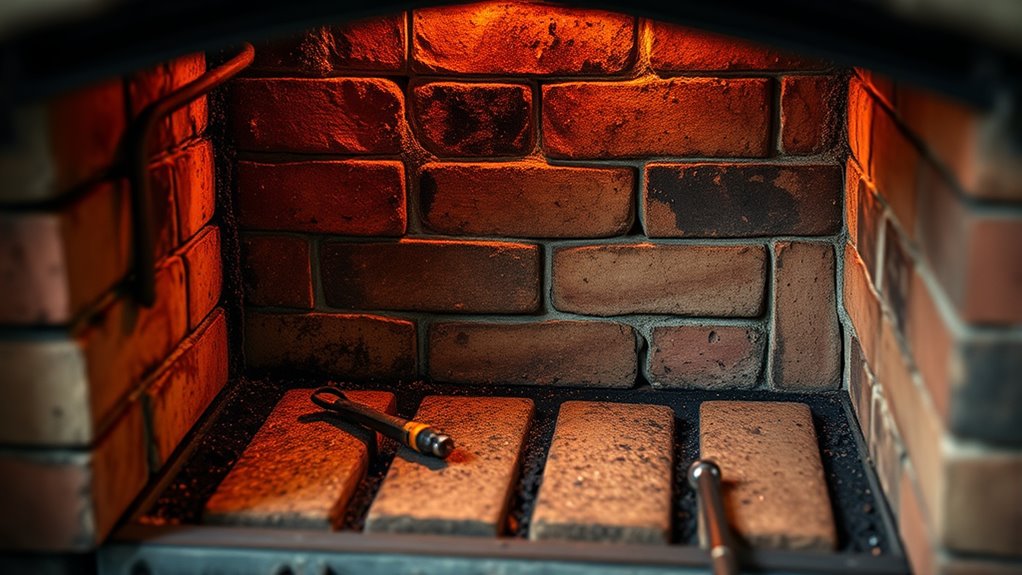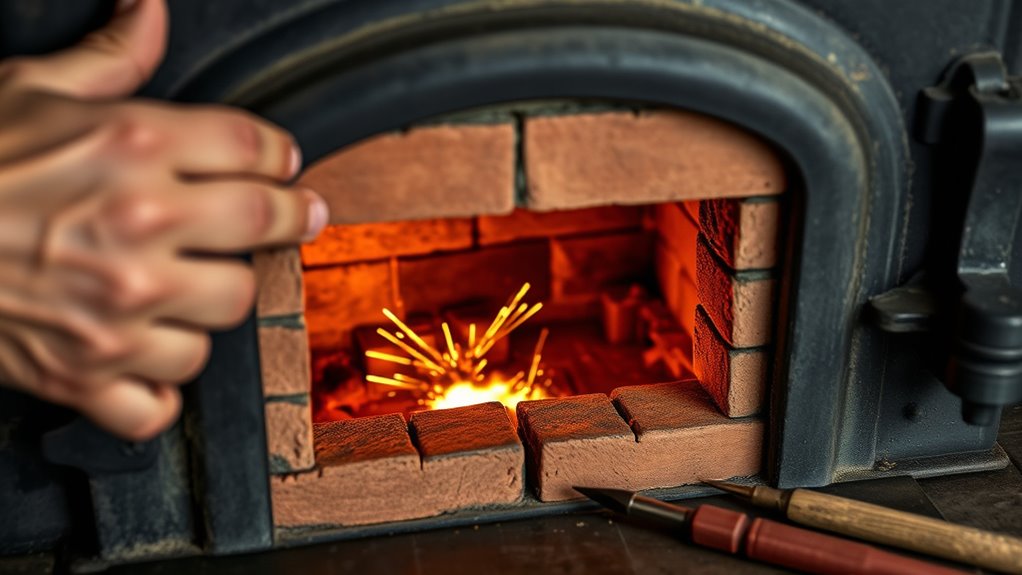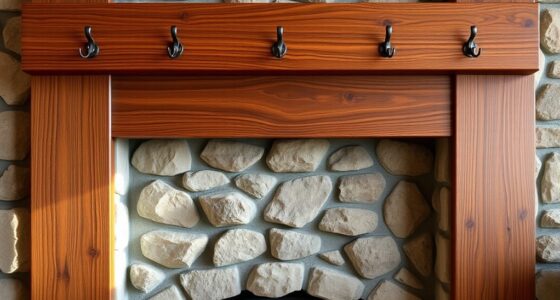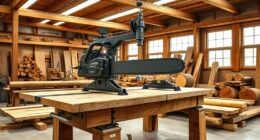To rebrick a small stove firebox, start by thoroughly cleaning the damaged area and removing loose debris. Gather high-temperature refractory bricks and heat-resistant mortar, then follow your manufacturer’s instructions carefully. Build your pattern by laying bricks evenly, ensuring gaps are filled with mortar for a strong bond. For best results, consider specific patterns or templates to match your stove. If you want detailed steps and expert tips, there’s more to learn on this process.
Key Takeaways
- Clean the damaged firebox area thoroughly before applying new refractory bricks or repair materials.
- Use high-temperature refractory mortar or heat-resistant epoxy to securely bond new bricks or patches.
- Select compatible refractory bricks or patterns matching the original firebox layout for proper fit and performance.
- Follow manufacturer instructions for curing and drying to ensure the repair’s durability and safety.
- Consider consulting a professional if the damage is extensive or if precise pattern replication is required.

If your small stove firebox has cracks or damage, repairing it promptly can prevent further deterioration and guarantee safe operation. Addressing issues early is essential for maintaining fire safety and ensuring your stove functions efficiently. A damaged firebox isn’t just a minor inconvenience; it can lead to dangerous leaks, reduced heat output, or even a fire hazard if left unaddressed. Proper stove maintenance, including timely repairs, keeps your appliance safe and prolongs its lifespan. When you notice cracks or signs of wear, it’s important to assess the extent of the damage and determine whether a repair or replacement is necessary. Small cracks, if caught early, can often be repaired using appropriate high-temperature materials designed for stove repair, such as refractory cement or heat-resistant epoxy. These materials provide a durable seal that withstands the extreme temperatures inside your firebox, restoring its integrity and preventing further damage.
Prompt repair of small stove firebox cracks prevents further damage and ensures safe, efficient operation.
Before starting repairs, make sure you have the right tools and materials at hand. Safety should be your top priority—wear gloves, eye protection, and a dust mask to avoid inhaling any debris or fumes. Clean the damaged area thoroughly, removing any loose or deteriorated material. This step ensures the repair adheres properly and provides a strong, lasting bond. Follow the manufacturer’s instructions carefully when applying repair compounds, and allow sufficient curing time before using the stove again. Proper stove maintenance includes regular inspections to catch potential issues early, which makes repairs smoother and more effective. Additionally, understanding the firebox materials used in your stove can help you choose the most suitable repair products for long-lasting results. Recognizing the material properties helps in selecting repair substances that will endure the high-heat environment. Regular inspections and understanding fire safety principles are essential for preventing accidents and ensuring your stove remains in optimal condition. Incorporating AI-driven diagnostics can further aid in detecting issues before they become serious, enhancing safety and efficiency.
In addition to repairing cracks, consider inspecting other key components of your firebox, such as the lining or refractory bricks. Damaged or worn bricks can compromise heat distribution and safety. If you’re unsure about the extent of the damage or how to repair it, consulting a professional can save you time and ensure the repair is done correctly. Remember, a well-maintained firebox not only enhances fire safety but also improves your stove’s efficiency, saving you money on fuel over time. Regular upkeep, including cleaning ash buildup and checking for corrosion, helps prevent major issues from developing.
Ultimately, addressing firebox damage swiftly and properly is a critical part of stove maintenance. It ensures safe operation, maintains heat output, and extends the life of your appliance. By taking the time to repair cracks and keep your stove in good condition, you’re investing in your safety and comfort. When in doubt, don’t hesitate to seek professional assistance—the safety of your home and loved ones depends on it. Proper care and timely repairs keep your small stove functioning safely and efficiently for years to come.
Frequently Asked Questions
What Safety Precautions Should I Take Before Rebricking a Firebox?
Before rebricking a firebox, you should wear protective gear like gloves, goggles, and a mask to stay safe from dust and debris. Make sure to verify your ventilation to prevent inhaling harmful fumes during the project. Turn off the power and allow the area to cool down completely. These precautions help ensure your safety while working on your firebox, making the process safer and more efficient.
Can I Rebrick a Firebox Without Professional Tools?
You can rebrick a firebox without professional tools, but it’s risky if you’re not careful. DIY safety is vital—use proper gloves, masks, and goggles. Investigate the theory that using the right firebrick selection makes the job easier and safer; it’s true. While basic tools like a chisel and trowel help, advanced equipment isn’t necessary. Just make certain you follow safety guidelines and choose quality materials for durability and safety.
How Long Does a Typical Firebox Rebricking Process Take?
A typical firebox rebricking process takes about one to three days, depending on your experience and the firebrick selection you choose. You’ll need to carefully remove old bricks, use proper rebricking techniques, and allow for adequate drying time between layers. Rushing can cause issues later, so take your time to make sure each step is done accurately. Proper planning and patience make the process smoother and more effective.
Are There Specific Types of Bricks Best Suited for Fireboxes?
Yes, certain bricks are ideal for fireboxes. You should use fire-resistant bricks made from refractory materials, as they withstand high temperatures and resist thermal expansion. Look for clay or alumina brick options, which are specifically designed for stove fireboxes. These materials guarantee durability, safety, and efficient heat retention, making your repair long-lasting. Always choose bricks rated for high heat to ensure your stove performs safely and effectively.
What Are Common Signs Indicating a Firebox Needs Rebricking?
You’ll know your firebox needs rebricking if you notice cracking bricks or rust stains around the firebox area. Cracks can weaken the structure, risking safety, while rust stains indicate moisture damage or deterioration of refractory materials. These signs suggest the bricks are compromised and may no longer withstand high temperatures. Addressing these issues promptly helps maintain efficiency and safety, preventing further damage and costly repairs down the line.
Conclusion
Rebuilding your small stove firebox might seem tricky, but with patience and the right pattern, you’ll have it working like new. Think of it as piecing together a puzzle—you just need to find the right fit. Don’t rush the process; enjoy the satisfaction of restoring your stove’s warmth and efficiency. Once done, you’ll feel proud, like a chef revealing a perfect dish. Keep at it, and your firebox will serve you well for years to come.










